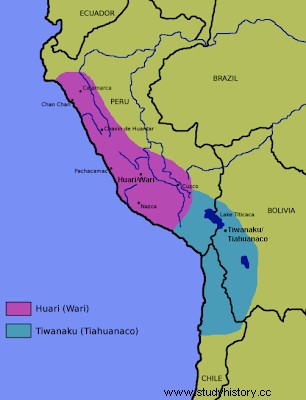
A COLONIZER STATE Its main center was the architectural complex of Tiahuanaco located on the Collao plateau 21 km south of Lake Titicaca, in the part of the Bolivian altiplano. From this point it spread throughout Bolivia, northern Argentina, northern Chile and southern Peru. Tiahuanaco had its geographic nucleus on the Collao plateau located at about 4,000 meters above sea level, located between Peru and Bolivia. The Tiahuanacos were heirs to the Pucará culture, which was one of the regional theocratic states of the Chavín era in the Altiplano region. The Pucará culture was the one that laid the formative foundations for the cultures that developed later in the Lake Titicaca region (Collahua, Ayrnara, and especially Lupacas de Chucuito), who achieved great livestock progress, developed high-altitude agriculture, with the construction of platforms and ridges (raised farms called waru waru) of which about 82,000 hectares are still in use in the Titicaca region.
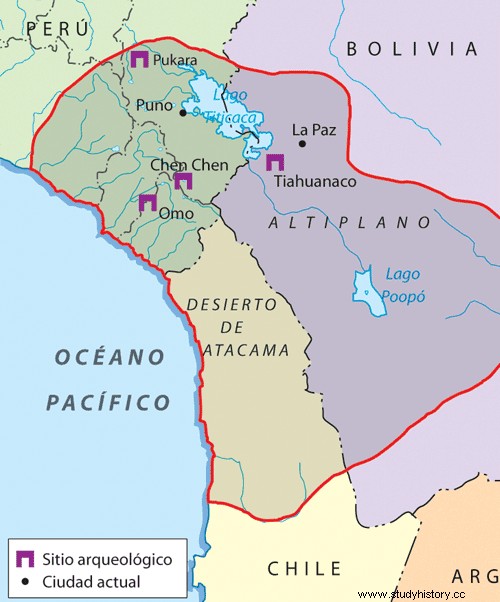
Similarly, the Pucará culture developed the monolithic sculptural tradition "Pucará Cutthroats" and the representation of a astronomer god or Wiracocha. Pucará was a true cultural bridge between Chavín (Estela Raimondi) and Tiahuanaco (Portada del Sol). Tiahuanaco pottery (3rd to 9th centuries AD) does not represent this divinity; however, in the constructions of the very center of Tiahuanaco, the Portal of the Sun or Intipunko is consecrated to the god Wiracocha, who has much more human and less fierce features than his previous lithic representation in Chavín. Tiahuanaco took the first steps to restore the expansive order of pan-Andean control, by establishing a centralized administration of the economy through a form currently called "archipelago policy"; This consisted of colonizing territories of other ecological levels, through enclaves, to produce or extract resources that did not exist or could not be produced in the Altiplano.
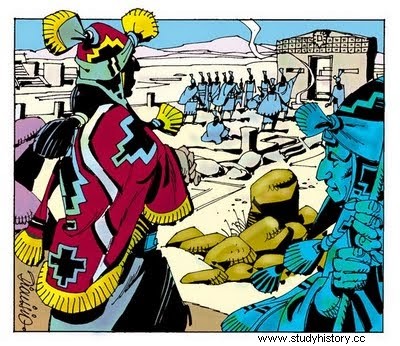
This colonizing policy of the theocratic-military State of Tiahuanaco gave it the possibility of extending its influence throughout :• The Taipi area or surrounding region of Lake Titicaca, zone of exchange with the region of the high peruvian fluvial yungas. In this central region, the labor force of various ethnic groups and an approximate nucleus of 10,500 inhabitants was controlled. potato, complementing the Puna cattle ranch.• The Quechua and Yunga maritime regions of Moquegua, Tacna and Arequipa, especially the inter-Andean valleys with high agricultural productivity.• The Chala region from Camaná to Iquique, a source of marine and mineral resources of copper in Tarapacá. To develop arsenical bronze.
CONTROL OF VARIOUS ECOLOGICAL AREAS: Tiahuanaco assimilated from the regional cultures of the Final Formative (theocratic, militarist, regional states), such as Pucará, techno-economic experiences that allowed it to stock up on complementary products to its local production; Given that the geographical environment of the Collao region offers many variations, such as droughts or floods that affected the productive apparatus, thus altering economic and social relations, both within the town and abroad. In the face of such a situation of instability and absence of commercial development at a supraregional level, the chiefs of the Tiahuanaco theocracy assimilated the practice of administrative control of productive nuclei in other regions, to complement their production. This economic policy, sustained through the establishment of nuclei or enclaves, under the control of the Tiahuanaco State, it is known by the name of "archipelagos" (group of islands); which was an effective precedent in the political administration and control of a maximum of ecological floors that would be further developed in Tahuantinsuyo.
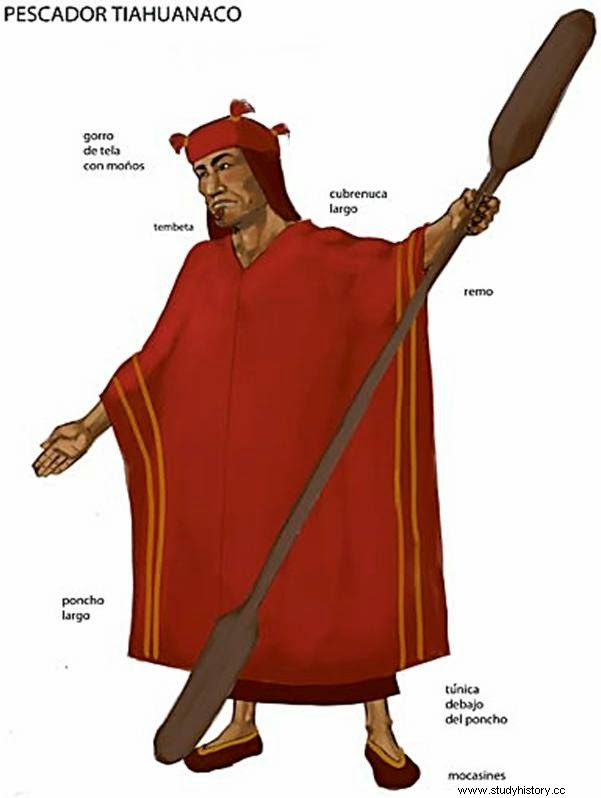 Tiwanaku Fisherman
Tiwanaku Fisherman 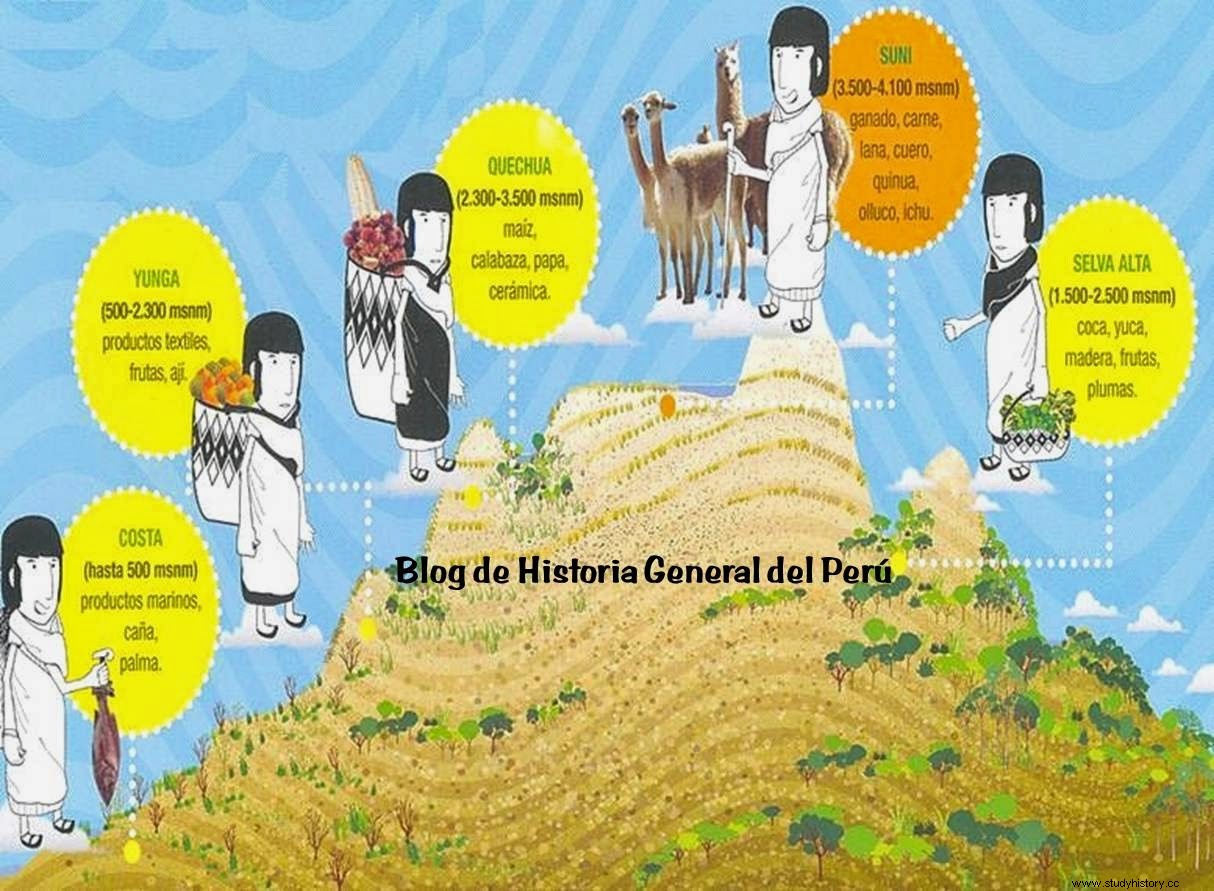
Tiahuanaco was able to expand through the following mechanisms: 1. Interregional alliances with the local ruling classes, which were consolidated with kinship ties between said ethnic groups or nations (interethnic exogamy), and thus legitimize their settlement in the respective region.2. The spread of the cult of Wiracocha or "astronomer God", as an ideological mechanism and justification of political and religious power.3. The exchange of knowledge made by the Tihuanaquenses with the other geographical regions and the respective synthesis allowed to develop:
- The metallurgy of bronze
- Techniques for expanding the agricultural frontier, with terrace systems and the "waru waru" or "ridges" already mentioned.
- Monolithic architecture and sculpture.
- Astronomical knowledge.
- The drying of foods such as potatoes (chuño) and meat (charqui).
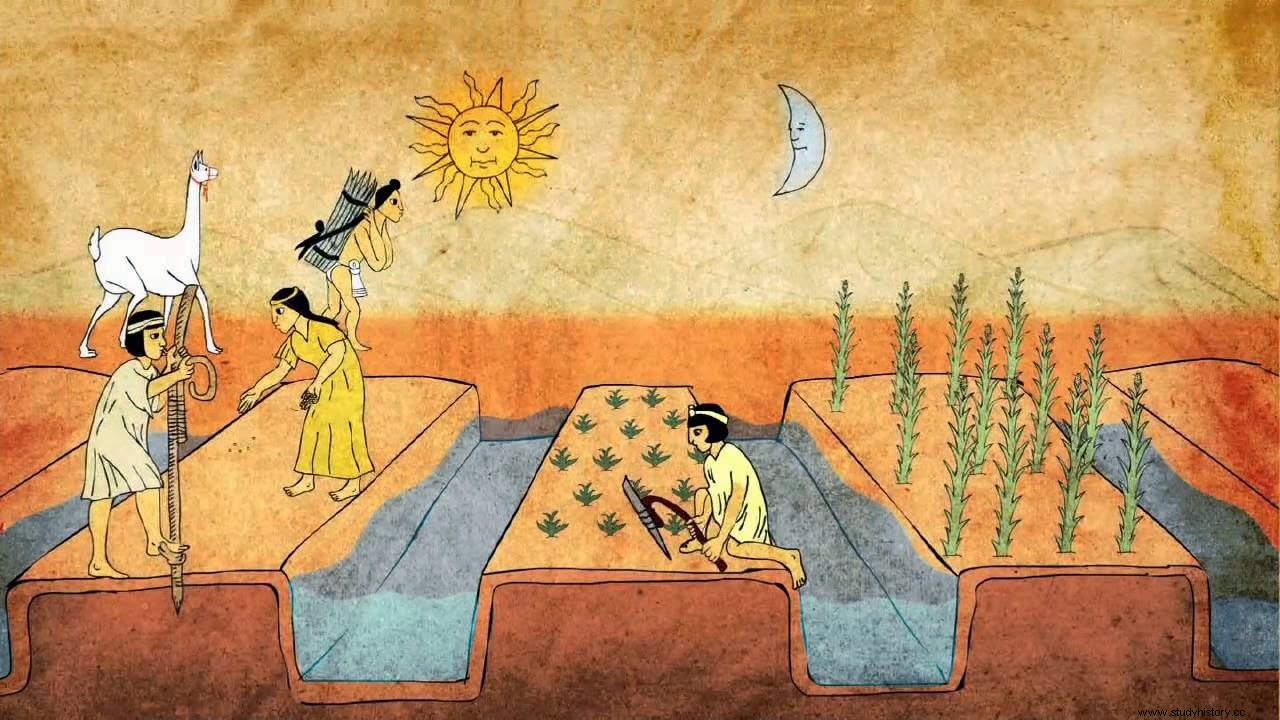 Despite the cold, the Tiahuanacos achieved harvests through the waru waru The architectural constructions of Tiahuana, according to some specialists, these gigantic works, have been carried out by thousands of slaves, whom a despotic government led by a military theocracy, interested in manifesting its power, forced to work like Cyclops. On the other hand, the people were forced to feed and clothe these thousands of workers on pain of severe penalties. In the execution of their work, the engineers made use of their ability and their shallow notions of art, but resorting to a series of instruments, such as the inclined plane, the embankment, the lever and perhaps the rollers. The mathematical regularity of the size and precision of the structures, the art shown in the drawing of the right and rounded angles that they make use of, speak eloquently of the architectural instinct of a race, "which carries out its work with the same instinctive certainty with which a bee builds the hexagonal cells of its hive" (Barcelli-19 81).
Despite the cold, the Tiahuanacos achieved harvests through the waru waru The architectural constructions of Tiahuana, according to some specialists, these gigantic works, have been carried out by thousands of slaves, whom a despotic government led by a military theocracy, interested in manifesting its power, forced to work like Cyclops. On the other hand, the people were forced to feed and clothe these thousands of workers on pain of severe penalties. In the execution of their work, the engineers made use of their ability and their shallow notions of art, but resorting to a series of instruments, such as the inclined plane, the embankment, the lever and perhaps the rollers. The mathematical regularity of the size and precision of the structures, the art shown in the drawing of the right and rounded angles that they make use of, speak eloquently of the architectural instinct of a race, "which carries out its work with the same instinctive certainty with which a bee builds the hexagonal cells of its hive" (Barcelli-19 81).ARTISTIC DEVELOPMENT OF TIAHUANACO: If on the coast, the so-called Early Intermediate, meant a notable artisanal development (Mochica and Nazca cultures), in the punas such progress was notoriously more modest, with the exception of the outstanding work in andesite stone, to elaborate monolithic sculptures. We have for example:
MEGALITHIC ARCHITECTURE:
All the constructions made by the Tiahuanaco present careful planning and are characterized by their large dimensions. The stone was the material they used, to secure the stones of the walls of their constructions they used tin-bearing copper staples. In the altiplano region, to the south east of Lake Titicaca (today Bolivia), they built temples, walled complexes, fortresses and ceremonial centers administrative (palaces). Among the main archaeological sites of Tiahuanaco is Akapana, with a pyramidal structure of 180 m2 by 15 m high, considered by some as Kalasasaya, there is the Puerta del Sol:(probably administrative ceremonial center); we also have the Templete, Putuni, Quericala and Pumapunko. The Templete is an underground temple whose floor is below ground level, it is decorated with nail heads on its interior walls. The constructions and artisans of Tiahuanaco joined the carved stones of andesite with copper staples thus giving more solidity to its temples, palaces and fortresses that until today subsist as evidence. These, together, present several elements that are still of interest for research. The reasons are:• They were not finished, being visibly truncated or unfinished. It is probable that the invasions of other peoples such as the Pacajes, Carumas, Oruros, Canas and perhaps Atacameños, frustrated the continuation of these works between the 9th and 11th centuries. d.n.e. • Use of copper staples to secure stone blocks in Tiahuanaco buildings. All these works were carried out with a great deployment of labor force for the benefit of the State leaders.
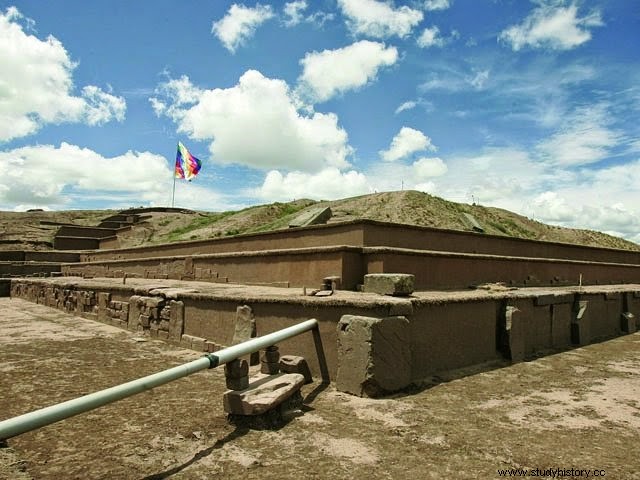

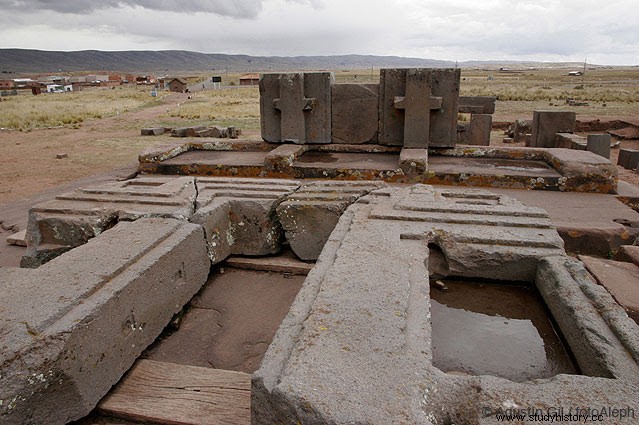
MONOLITHIC SCULPTURE
The builders and artisans of Tiahuanaco joined the carved andesite stones with copper staples thus giving more solidity to their temples. palaces and fortresses that until today remain as evidence. Another notable artistic expression was sculpture. The monolithic sculptures of Tiahuanaco were made of andesite stone. Among them, the Puerta del Sol or Intipunko and the Bennett and Fraile monoliths stand out.
The Bennett monolith is the largest of all the sculptures, measuring 7.30 m high, it was made based on a single red sandstone, it represents an anthropomorphic being that carries a scepter and a kero-type glass in his hands.
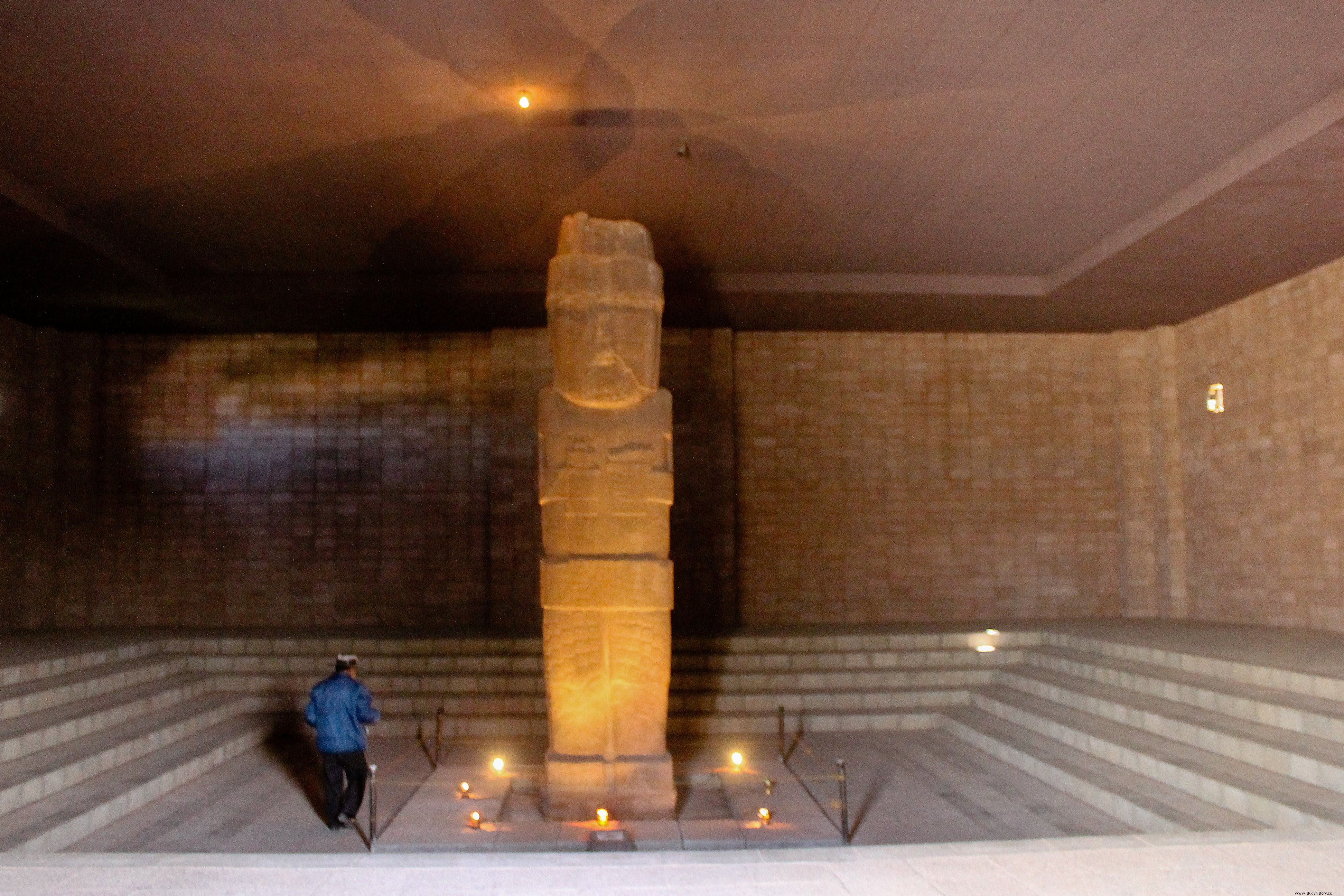
In the Cover of the Sun The "astronomer God" appears represented, from whose eyes tears drain due to the effect of solar radiation, since his gaze is oriented to the observation of space. It is a single stone 4 m long by 2.18 m high, it has a central doorway 1.37 m high and 83 cm wide. In the central part, the god Wiracocha is represented, it measures 81 cm high by 54 cm wide, it is carefully worked in high relief, it presents in each hand canes or scepters that end in condor heads, twenty-four rays come out of its head where they appear alternately circles and felines. He is a more human character, compared to the mythical man-animal being of the Raymondi stele of Chavín; the latter, true anthropomorphic synthesis of the triad:feline, serpent and eagle. However, the god on the Portal of the Sun also displays rays that start from his head and transform into feline faces, a symbol of power.
The set also features 48 mythical winged figures sculpted in profile, which according to some researchers could integrate a kind of astronomical calendar; hence its connection with agricultural development, which would explain the diffusion of the "astronomer God" also with the Wari expansion among the other Andean peoples, during the Middle Horizon, which we will study later.
The central character bears some relation with the character of the Estela Raimondi de Chavín. Only that the character from Tiahuanaco humanizes the feline features of Chavín, perhaps this was due to the artist's style or to the fact that social relations in Tihuanaco were not based on terror. For this reason, it is said that there must have been a continuity between Chavín and Tiahuanaco.
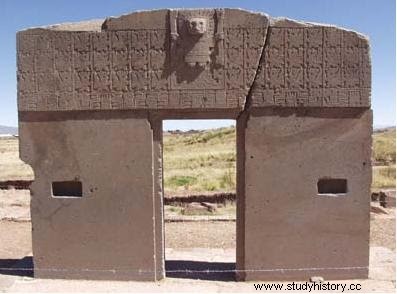
&esite> (Sun Cover).
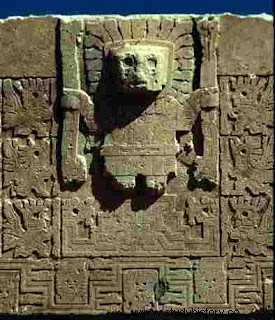
STYLIZED CERAMICS
Tiahuanaco developed a ceramic of fine and fragile clay, with winged anthropomorphic motifs:it combined human beings with falconids (condors, falcons), felines, snakes, camelids; They configured a baroque decoration of images, finally enclosed between rectilinear lines. The orange color predominates and the ceremonial vessels (kero type), as well as the classic cauldrons or incense burners (to smoke). These artistic works were elaborated, with a lot of patience and investment of time, by the artisans to fulfill the interests of the ruling class, who only directed and administered that society.
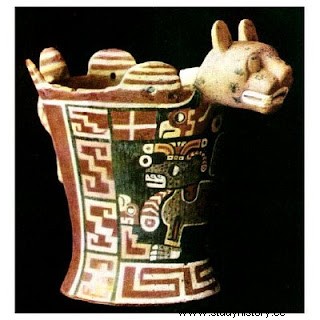
METALLURGY
As was said before, they achieved the alloy of copper from Tarapacá and tin (from present-day Bolivia) in wayras or furnaces, thus achieving bronze to improve production instruments in the Andean world; With this, there was a great advance in the productive forces. About the wayras. . . They managed to alloy copper and tin to produce bronze, which allowed them to make harder tools for carving stone. From copper they made staples to join the stone blocks. The alloy of copper with tin was possible because they discovered the mines of this last metal located in Chayanta and Yamparaés (department of Chuquisaca, Bolivia). The bronze that they discovered was spread throughout the Andes. The metallurgy of copper allowed them to be transformed by casting and casting in molds, for which high temperatures were necessary, which was possible to achieve thanks to special ovens called guayras because they were blown. by the wind. Gold and silver were worked to forge ornaments, shrines, necklaces, earrings, rings, bracelets. . . (Espinoza - 1983).
TEXTILERIA It was characterized by its tapestries made with the "accordion technique", that is, its drawings appear compressed like the folds of an accordion, which must be stretched to understand the design, which ranges from the figurative to the abstract. All these elements cultural events will be an essential part of the second great Pan-Andean synthesis that supported the formation of the Wari Empire.
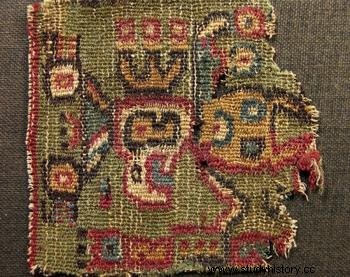
IDEOLOGY The priests tried to base a mythical-divine worldview, they also considered themselves divine because they claimed to represent their gods, and their gods were anthropomorphic (human and feline form), falcon or serpent. Their most important god was Wiracocha (foam of waters). They managed to explain and control the forces of nature with the astronomical, mathematical and geographical knowledge they achieved in the field of science.


VIDEO
